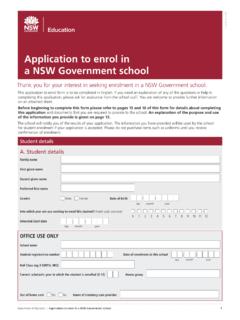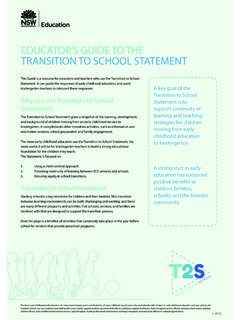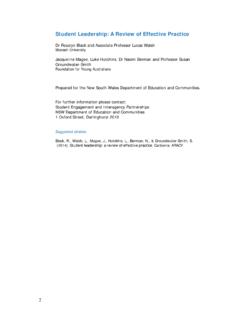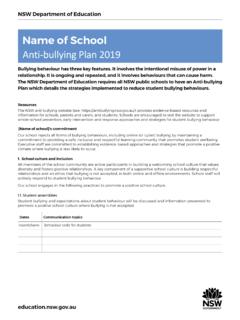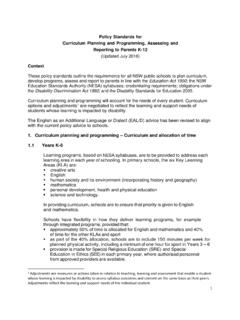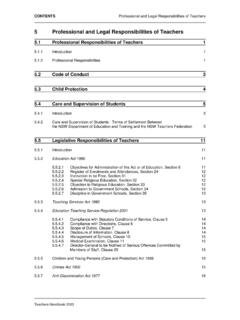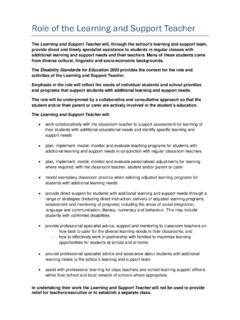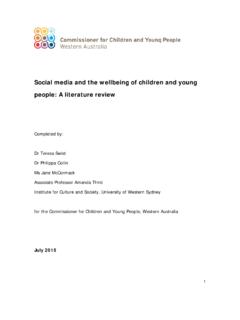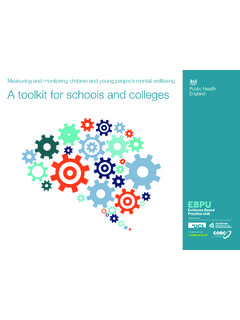Transcription of The Wellbeing Framework for schools - education.nsw.gov.au
1 April 2015. CONNECT SUCCEED THRIVE 21/04/15_16531. THE Wellbeing . Framework FOR schools . NSW Department of Education and Communities | The Wellbeing Framework for schools Introduction The NSW Department of Education and Communities (DEC) is committed to creating quality learning opportunities for children and young people. This includes strengthening their cognitive, physical, social, emotional and spiritual development. Parents entrust their children and young people to principals, teachers and school staff with confidence that schools will deliver on this agenda. The concept of Wellbeing and its close links with The themes that will drive Wellbeing in our public learning are not new. A wealth of evidence is schools into the future are Connect, Succeed and available to inform educators of this important Thrive.
2 Our commitment to our students, parents relationship in the work they do every day with and members of the community is that public students, from preschool students beginning their schools will be teaching and learning environments education journey, to senior students preparing for that enable the development of healthy, happy, further education, employment and adult life. successful and productive individuals. In recent years however, there have been changes In turn, our students will be expected to contribute to how children and young people learn and how to their own Wellbeing , the Wellbeing of their teachers teach. The school environment, and the peers and the collective Wellbeing of their world in which our children and young people will communities.
3 In this way schools in partnership grow and function, continue to change. We need to with parents and carers will equip children and be responsive to numerous influences as we deliver young people to be active and positive contributors public education now and into the future. to the society in which they live. There is a heightened awareness of, and commitment schools will be supported at every level by a system to, personalised and differentiated learning and that is cohesive, expert and responsive. Information support for every student to succeed. There is for school leaders and school staff will be clear targeted support at the system and school levels so and easy to access; policies will be streamlined that where a child or young person lives and goes to and meet the modern operating context of our school does not shape their learning outcomes.
4 schools ; resources will be positioned in schools to drive contextual decision making and planning;. In this context, our understanding of Wellbeing educational services will be coordinated at the local needs to be contemporary and forward-focussed. level and will be responsive to the needs of schools . An individual's Wellbeing is constantly changing. Education will work with government and non- How students feel about themselves and their own government agencies to develop partnerships to Wellbeing changes over time, in different situations enhance the collective Wellbeing of schools and circumstances, and in response to community and their communities. and environmental factors. Wellbeing , or the lack of it, can affect a student's engagement and Student Wellbeing is enhanced when schools success in learning.
5 Educators need to understand connect with and draw on the expertise, the potential Wellbeing has to bring about positive contribution and support of their communities. change, what is required to foster Wellbeing , and Community engagement maximises how how it can become a powerful force in students' students connect, succeed and thrive. learning and development. 2 NSW Department of Education and Communities | The Wellbeing Framework for schools Rationale What is Wellbeing ? Spiritual Wellbeing relates to our sense of meaning and purpose. It can include our connection to It has long been acknowledged that Wellbeing is culture, religion or community and includes the more than the absence of physical or psychological beliefs, values and ethics we hold.
6 Illness. In very broad terms, Wellbeing can be described as the quality of a person's life. These domains of Wellbeing are helpful in describing the contexts in which Wellbeing is Two major approaches to defining Wellbeing relate experienced. However, to understand Wellbeing it to our subjective experience of feeling good or more deeply we must also consider a range of other experiencing pleasure and positive emotion; and influences that contribute to Wellbeing . functioning well, or our potential to flourish. While there is debate about whether one or both of these approaches to Wellbeing offers the best way of How can schools positively influence understanding it, an approach that considers the the Wellbeing of students?
7 Whole person, and which combines feeling good Wellbeing can be shaped by a number of broad and functioning well offers the most utility. influences including the degree to which there is an The literature sets out a range of contexts in experience of: choice, achievement of meaningful which Wellbeing is experienced. These contexts goals, positive relationships, enjoyment, personal recognise that Wellbeing needs to be considered growth and development, health, and safety. against a background of how we feel and function Choice is important because it impacts across several domains, recognising the multi- positively on a student's learning and engagement dimensional nature of Wellbeing . These domains in schooling. It contributes to enhanced include cognitive, emotional, social, physical motivation, interest and commitment to tasks.
8 And spiritual Wellbeing . The provision of choice supports self-regulation, Cognitive Wellbeing is associated with achievement self-discipline and achievement. When students and success. It includes how information is have choice and opportunities to engage in processed and judgements are made. It is also activities that are of interest and value to them, informed by motivation and persistence to achieve. their Wellbeing is enhanced. Cognitive Wellbeing is important for attaining Achievement contributes positively to a student's knowledge and experiencing positive learning. Wellbeing , and can contribute to a student's Emotional Wellbeing relates to self-awareness and confidence and self-esteem. It can help to foster emotional regulation.
9 It includes how well we cope, student self-discipline and effort, encourage and is often reflected by the level of a person's students to stretch themselves and take risks in their resilience. Emotional Wellbeing is in part informed learning. Achievement fosters positive emotions by our capacity for self-reflection. which can build further engagement and effort. Social Wellbeing includes the extent to which we Positive relationships foster connectedness experience positive relationships and connectedness and feelings of belonging and are essential for to others. It is important for pro-social behaviour Wellbeing . These relationships are characterised and our empathy towards others. by constructive interactions that provide enthusiastic and genuine support.
10 They are Physical Wellbeing is associated with the extent to important because they help us to build social and which we feel physically safe and healthy. It includes emotional skills and in turn nurture other positive, nutrition, preventative health care, physical activity caring and respectful relationships. and physical safety and security. Physical Wellbeing enables positive health outcomes. NSW Department of Education and Communities | The Wellbeing Framework for schools 3. Enjoyment, or the presence of positive emotion, Why is Wellbeing important to the can increase a student's Wellbeing . Learning work of schools ? occurs more effectively in the context of positive schools have a pivotal role to play in connecting emotions.
